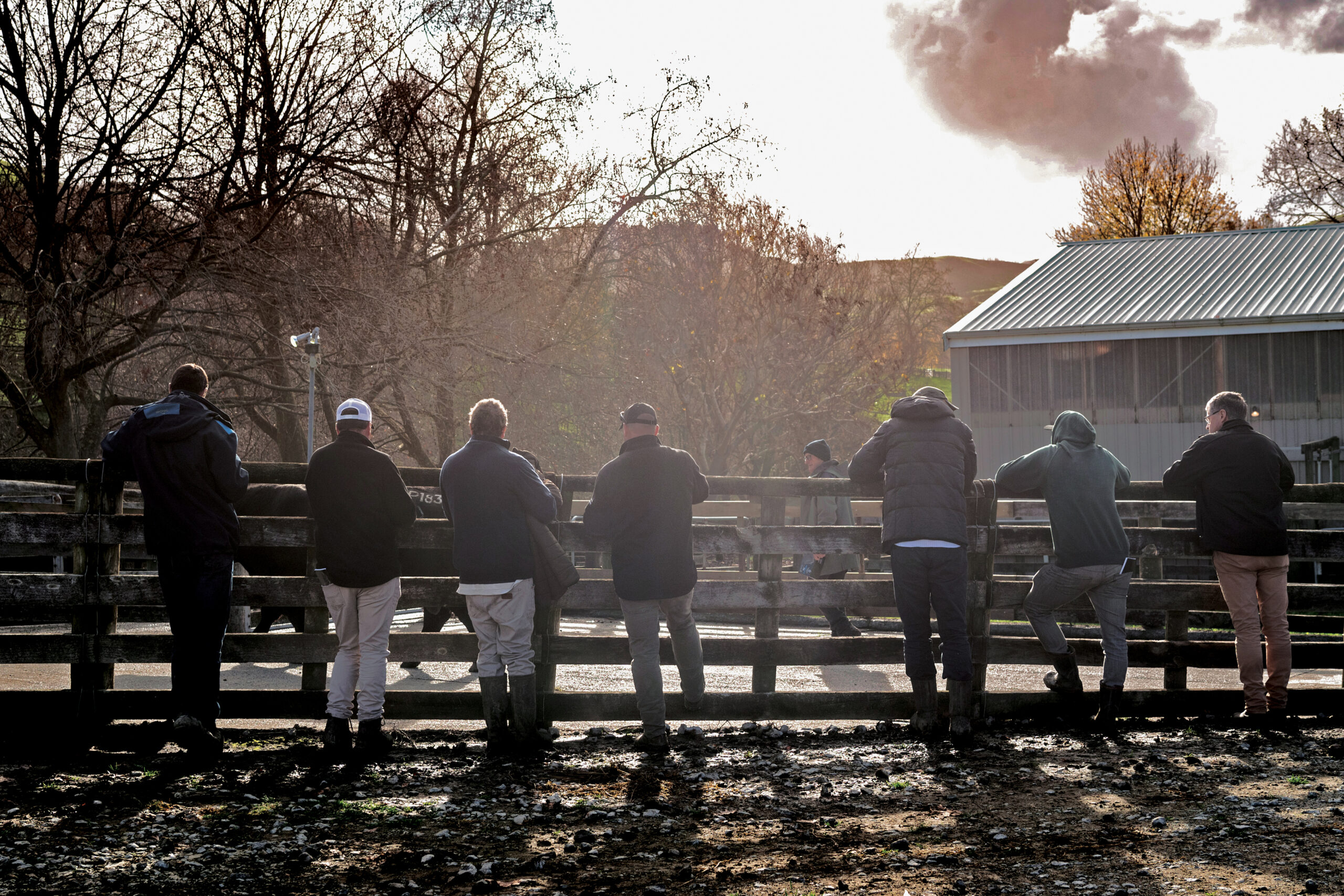
GUIDE FOR
INSPECTORS
FOR BETTER BALANCED BEEF
The Inspector is NOT judging the animal. The task is to assess an animal for unacceptable faults in the breed. The inspector should keep in mind the effects different environments have on the size and condition of the cattle being inspected.
Guide for Inspectors
- The Inspector is NOT judging the animal. The task is to assess an animal for unacceptable faults in the breed. The inspector should keep in mind the effects different environments have on the size and condition of the cattle being inspected.
- Upon arriving at the farm, the Inspector(s) can refuse to carry out the inspection if the facilities are not up to standard ie. If the yards are not workable, and the cattle cannot be inspected properly eg. feet require a concrete floor or dry firm ground to be available.
- Identification is critical whether an animal is transferable or not. Fire brands for station numbers and station brands should be clipped, freeze brands easily readable and a head bail available to read tattoo’s. If these are not distinguishable the animal can not pass inspection for “Approval” NOR can it be transferred.
- The Inspector should be able to discuss his decision frankly and honestly with the breeder.
Jaws
Must be flush with pad. Any doubt with a short bottom jaw and the Inspector must head bail the animal and inspect the jaw. Sometimes jaws that look short on eye appraisal prove not to be when put in a head bail and inspected. Excessively shallow bottom jaws will not be tolerated.
Feet
Straight Toes
Grain of foot
horizontal to ground

Curled Toes
Grain of foot not
horizontal to ground
This always is the most contentious issue from all sides. Naturally some of the wetter areas of New Zealand have more problems with feet than the drier areas.
Insist on a concrete block or yard. Washing facilities should be available, especially under muddy, winter conditions. Always have the animal walked towards and away from you as this quickly points out bad or rolling feet. Older cattle, especially cows, should be given a small degree of tolerance.
- Front Feet – Excessively turned out front feet/legs are not acceptable. They should not have any sign of excess growth, inwards turn, cracks or roll.
- Hind or Rear Feet – Faults similar to front feet, but the main fault can be the outside claw being smaller than the inside claw. This can lead to excessive growth and rolling. Animals down on back pasterns can also lead to excessively long back feet. Neither should be tolerated.
- Cracked Feet – This can be an environmental problem to some degree, as well as hereditary. Obviously cracked feet will not qualify as “Approved”.
Testicles – Normal Too high Too small
Must be 35 cm circumference minimum at 18 months at the widest point. By 2 years old they should be 37 cm minimum to qualify for “Approval”. A tape measure should be carried and used if in doubt. Crossed testicles or one up and one down are not acceptable.
Shoulders
Females should have smooth fine shoulders fitting nicely and in balance with the animal. Watch for rough shoulders, or shoulders that are mounted slightly forward. Shoulders should not rise above the spine. These problems can cause foot roll and calving problems.
In the male the shoulder can be larger and a little rougher than the female but should fit nicely and be in balance. Ideally they should not rise above the spine and the shoulder blades should not be loose.
Forelegs
The following faults should be looked for:
- Turned out legs.
- Turned in legs.
- Excessively wide or narrowly spaced legs.
Fig 2
Normal
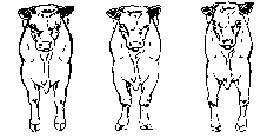
Knock Kneed
Bow legged
Figure 2 shows correct and faulty structure which can be seen from the front view and is self explanatory. Faulty structure obviously impairs mobility and increases the danger of joint failures resulting in arthritis and structural foot faults.
Hind Legs
The following faults should be looked for:
- Sickle hocked & low in pasturn.
- Straight hocked.
- Cow hocked.
- Bow legged.
Fig 3
Correct
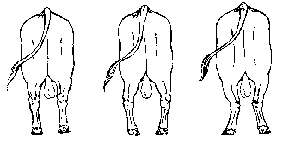
Bow legged
Cow hocked
Fig 4
Correct
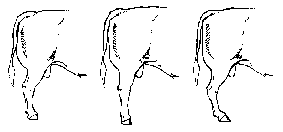
Straight hock
Sickle hocked
Low in pasturn
Excessive White
All registered cattle can be transferred in this area although cattle that fall into the Excessive White area will never be “Approved”.
In males, white or grey hairs on pigmented skin are acceptable on the pizzle provided they are not excessive and do not extend up the sheath towards the belly. Intermittent white spots between the inside folds of the flanks or along the underline between the scrotum and the junction of the sheath and belly are permissible but must not be excessive in area.
In females, the white must be behind the navel and a small amount of white hair on the tip of the vulva is not considered detrimental. White tail hairs can only be accepted as a minority compared to black hairs.
Adeske Marks
White or grey hair on pigmented skin is acceptable and will qualify for “Approval”.
Scurs
Are not acceptable for transfer or Approval.
Wounds and Lameness
Always look for injuries and wounds as sometimes these can make an animal unsuitable for breeding or can be affecting the structure of an animal. A veterinary certificate should be produced if in doubt to qualify for “Approval”.
Sheaths
Desirable Sheath
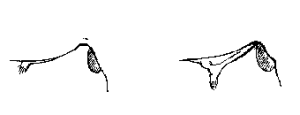
Sheath Loose,
undesirable sheath
Unduly pendulous sheaths should not be allowed and will not qualify for approval.
Breed Type
The animal must conform to the historic and natural characteristics of the breed and be of a reasonable size.
Temperament
Bad natured, highly irritable or wild cattle will not qualify for “Approval”.
Appeal
Any vendor who questions the Inspector(s) decision on any animal or animals refused “Approval” , may within 7 days appeal the decision and request re-inspection. Within 14 days Council shall appoint an Inspection Committee of three Inspectors to reinspect the animal(s).
The Inspection Committees decision shall be final. The cost of reinspection shall be borne by the vendor concerned except in the case where the appeal is upheld, when the expenses will be borne by the Association. There is to be no interference with the animal between the initial inspection and the appeal.
Conclusion
This manual attempts to standardise procedure for the new Inspection System. Because this system is a quality control system, Council will from time to time instruct Inspectors to tighten up in certain areas that are causing concern to the breed. This will not impact on another breeders right to purchase an animal for transfer. Council will monitor the Inspection System to make sure its achieving what it is intended to do ie. To improve the quality of Angus cattle in New Zealand.
Inspectors will inspect
using a simple motto
“If in doubt, its out!”
Acknowledgements
The Inspection of Angus Cattle
A Guide for Inspectors
Edited by P A Newman
